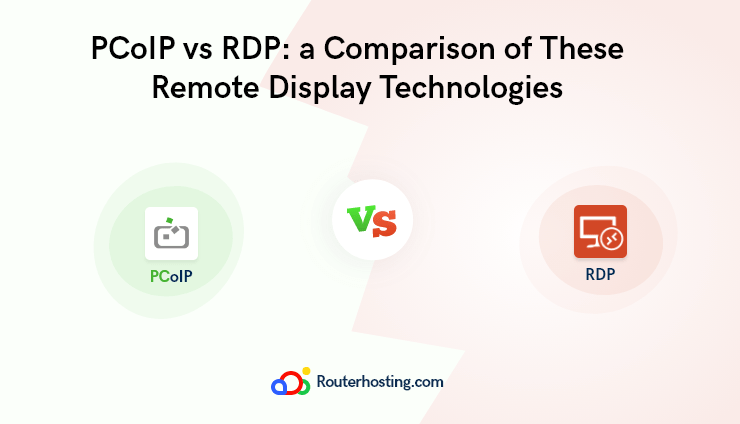Nowadays having one computer is not the best thing for everyone. There are different types of needs that different types of computers fulfill. For example, a laptop provides portability while a desktop pc provides amazing performance capabilities.
As it is impossible to carry around a desktop PC or expect extreme performance from a laptop, remote use is the best and most efficient option. Here you are using one device to control the other one, and it improves the overall productivity by a huge factor.
When it comes to using different computers, many protocols and applications serve the purpose. However, each has its benefits and demerits that you can only know after having the experience.
What is the difference between VMware Blast, PCoIP, and RDP?
In this fast-paced life, everyone can’t keep changing their working protocols as it takes a long time to get used to something. It makes the VMware Blast vs PCoIP vs RDP selection confusing for people as they do not know what they are getting themselves into.
So, to make things easier for you here, we will be having a thorough VMware Blast vs PCoIP vs RDP comparison. This comparison will tell you the details about each of the protocols and whether you should select it or not. Moreover, the comparison table below will also help in making the final decision of selecting the best protocol for you.
However, before jumping right into the comparison, it is important to get a general overview of the significance of each of these protocols and how they bring value to you.
What is VMware Blast?
It is a display protocol developed to provide an amazing user experience of working across different devices remotely. It is developed by VMware and comes included with the VMware Horizon and many other VMware products.
What is PCoIP?
PCoIP stands for PC over IP. It is a remote connection protocol that provides an amazing user experience in remote access to a PC. Apart from remote access, it comes with many features like security, file transfer, cross-device communication, and a lot more.
What is RDP?
RDP stands for Remote Desktop Protocol. It is a protocol for remote access of computers that Microsoft developed. It was a part of the Remote Desktop Service(RDP), and it allows people to control their desktop computers remotely. It also brings some additional features like transmitting data.(Read : how to change rdp port)
While the main functionality of all three of these is remote desktop access, there are many differences between them. RDP works for different desktops, while VMware Blast and PCoIP only come with support for the published applications. Here is a more in-depth comparison of all three of these.
VMware Blast vs PCoIP
Let us start with the PCoIP vs blast comparison. There are not many things that differ, but the ones that differ make a huge difference and gaps between the performances. So, in this PCoIP vs VMware Blast comparison, we will be covering the most significant factors.
Client support
The client support for VMware Blast is quite wide. It supports clients for the following devices:
- Windows
- Mac
- Linux
- Chrome
- Android
- iOS
PCoIP also works with a wide range of client-supported devices.
Port redirection
USB port redirection works on both, but there are some limits in either case.
Multiple monitors
VMware Blast supports 2 monitors for 1920×1200 resolution. However, for 4K resolution, only 1 monitor is supported. On the other hand, PCoIP provides a view desktop of a maximum of 4 monitors.
This was the VMware Horizon client PCoIP vs Blast comparison.
VMware Blast vs RDP
Client support
VMware Blast supports a lot of client devices, including Windows, Mac, Linux, Chrome, Android, and iOS. On the other hand, RDP only works on the computers running on supported versions of Microsoft Windows.
Port redirection
USB port redirection works on both, but there are some limits in either case.
Multiple monitors
VMware Blast supports 2 monitors for 1920×1200 resolution and only 1 for 4K resolution. RDP, on the other hand, provides the maximum number of 7 monitors with a view display of 16.
PCoIP vs RDP
Client support
PCoIP works with mobile devices along with computers. However, in the case of RDP, the Microsoft Windows computers with supporting operating system versions are the only client choice.
Port redirection
USB port redirection works on both, but there are some limits in either case.
Multiple monitors
PCoIP works with a view desktop of 4 monitors at max. On the other hand, the RDP provides the maximum number of 7 monitors with a view display of 16.
VMware Blast vs PCoIP vs RDP comparison table
The following is the VMware Blast vs PCoIP vs RDP comparison table. By taking a good comprehensive look at this table, you can decide which of the protocols is best for you.
| VMware Blast | PCoIP | RDP | |
| CPU Load Requirements | Pentium 4, 2.0 GHz processor, equivalent or better | Any processor supporting SSE 4.2 | Any quad core 2.0 GHz or better |
| User Experience | Good | Best | Normal |
| Battery Life | Normal | Good | Best |
| Client Support | Best | Good | Only works with Microsoft Windows devices |
| Port Redirection | Yes(limited) | Yes(limited) | Yes(limited) |
| Multiple Monitors | 2 max | 4 max | 7 max |
So, this table can show you the comparison which is required to quickly understand your needs and requirements. You can decide what is best for you.
Final Remarks:
Selecting the right protocol in this VMware Blast vs PCoIP and RDP comparison is very important as the protocol can affect your performance and productivity. If we take a general look, then PCoIP can be the best choice for everyone considering that it uses UDP and comes with a lot of other amazing features.
However, this can differ for different users according to the requirements.
So, when you are doing the PCoIP vs Blast vs RDP comparison, make sure that you know all your requirements and then make the final decision according to the protocol that suits your needs in the best manner. Trust reliable RDP suppliers and enjoy your shared environment














